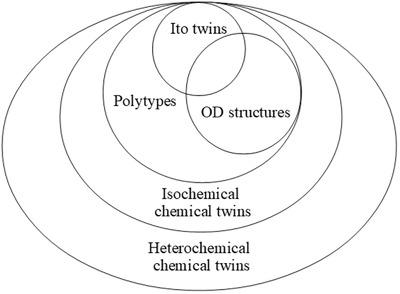当前位置:
X-MOL 学术
›
Cryst. Res. Technol.
›
论文详情
Our official English website, www.x-mol.net, welcomes your feedback! (Note: you will need to create a separate account there.)
The Japanese Pioneering Contribution to the Investigation of Modular Structures
Crystal Research and Technology ( IF 1.5 ) Pub Date : 2019-08-04 , DOI: 10.1002/crat.201900045 Akihiro Umayahara 1, 2 , Massimo Nespolo 1
Crystal Research and Technology ( IF 1.5 ) Pub Date : 2019-08-04 , DOI: 10.1002/crat.201900045 Akihiro Umayahara 1, 2 , Massimo Nespolo 1
Affiliation

|
Modular crystal structures are built by regularly juxtaposing 0-, 1-or 2-periodic modules. When the modules are obtained from the same archetype, the resulting structure is known as monoarchetypal and has been called a cell-twin. At the interface between two modules the coordination environment may be altered with respect to the archetype, leading to a chemical modulation that accompanies the structural variability. When such a modification of the coordination does not occur the result is a series of polytypes, whose building modules are not limited to layers, although the latter represent the most common examples. The symmetry theory of polytypes was developed by the OD school, which however considered only layers as building modules, and only those polytypes in which pairs of layers are geometrically equivalent. Well before the OD school, Ito in Japan recognized the need of a wider algebraic structure to deal with polytypes, which he called "polysynthetic structures", today known as "Ito twins". He called this algebraic structure "twinned space groups", because of the geometric similarity between layers in modular structures and individuals in twins; further, from his empirical analysis of examples from minerals he considered only digonal operations, i.e. operations whose linear part has order two. His approach was later expanded by Sadanaga to include other types of operations and in particular operations other than digonal. Sadanaga recognized that Ito's "twinned space groups" are space groupoids and proposed a classification in which polytypes were exclusive of Ito twins, contrary to the official definition. In this article we trace back the contribution of the Japanese school to the field, which is mostly unknown because published in rare and hardly accessible journals and partly in Japanese; we show that, despite some confusion in the language, the fundamental concepts later developed in a more systematic way, were already present, in a nutshell, in the works of Ito and Sadanaga; finally, we propose a slightly revised classification of monoarchetypal modular structures which better reflects the original contribution by the Japanese school.
中文翻译:

日本对模块化结构研究的开创性贡献
模块化晶体结构是通过有规律地并列 0、1 或 2 周期模块来构建的。当模块从相同的原型中获得时,由此产生的结构被称为单原型,并被称为细胞孪生。在两个模块之间的界面处,协调环境可能会根据原型而改变,从而导致伴随结构可变性的化学调制。当这种协调的修改不发生时,结果是一系列多型,其构建模块不限于层,尽管后者代表了最常见的例子。多型体的对称理论是由 OD 学派发展起来的,但它只将层视为建筑模块,并且只考虑层对几何等价的多型体。在 OD 学校之前,日本的伊藤认识到需要更广泛的代数结构来处理多型,他称之为“多合成结构”,今天称为“伊藤双胞胎”。他将这种代数结构称为“孪生空间群”,因为模块化结构中的层和孪生中的个体之间的几何相似性;此外,根据他对矿物实例的实证分析,他只考虑了对角运算,即线性部分为二阶的运算。他的方法后来被 Sadanaga 扩展到包括其他类型的操作,特别是对角线以外的操作。贞永认识到伊藤的“孪生空间群”是空间群,并提出了一种分类,其中多型不包括伊藤孪生,这与官方定义相反。在这篇文章中,我们追溯了日本学派对该领域的贡献,该领域大多不为人知,因为发表在稀有且难以访问的期刊上,部分是用日语发表的;我们表明,尽管在语言上有些混乱,但后来以更系统的方式发展起来的基本概念,简而言之,已经存在于伊藤和贞长的作品中;最后,我们提出了一个稍微修改的单原型模块结构的分类,它更好地反映了日本学派的原始贡献。简而言之,在伊藤和贞长的作品中;最后,我们提出了一个稍微修改的单原型模块结构的分类,它更好地反映了日本学派的原始贡献。简而言之,在伊藤和贞长的作品中;最后,我们提出了一个稍微修改的单原型模块结构的分类,它更好地反映了日本学派的原始贡献。
更新日期:2019-08-04
中文翻译:

日本对模块化结构研究的开创性贡献
模块化晶体结构是通过有规律地并列 0、1 或 2 周期模块来构建的。当模块从相同的原型中获得时,由此产生的结构被称为单原型,并被称为细胞孪生。在两个模块之间的界面处,协调环境可能会根据原型而改变,从而导致伴随结构可变性的化学调制。当这种协调的修改不发生时,结果是一系列多型,其构建模块不限于层,尽管后者代表了最常见的例子。多型体的对称理论是由 OD 学派发展起来的,但它只将层视为建筑模块,并且只考虑层对几何等价的多型体。在 OD 学校之前,日本的伊藤认识到需要更广泛的代数结构来处理多型,他称之为“多合成结构”,今天称为“伊藤双胞胎”。他将这种代数结构称为“孪生空间群”,因为模块化结构中的层和孪生中的个体之间的几何相似性;此外,根据他对矿物实例的实证分析,他只考虑了对角运算,即线性部分为二阶的运算。他的方法后来被 Sadanaga 扩展到包括其他类型的操作,特别是对角线以外的操作。贞永认识到伊藤的“孪生空间群”是空间群,并提出了一种分类,其中多型不包括伊藤孪生,这与官方定义相反。在这篇文章中,我们追溯了日本学派对该领域的贡献,该领域大多不为人知,因为发表在稀有且难以访问的期刊上,部分是用日语发表的;我们表明,尽管在语言上有些混乱,但后来以更系统的方式发展起来的基本概念,简而言之,已经存在于伊藤和贞长的作品中;最后,我们提出了一个稍微修改的单原型模块结构的分类,它更好地反映了日本学派的原始贡献。简而言之,在伊藤和贞长的作品中;最后,我们提出了一个稍微修改的单原型模块结构的分类,它更好地反映了日本学派的原始贡献。简而言之,在伊藤和贞长的作品中;最后,我们提出了一个稍微修改的单原型模块结构的分类,它更好地反映了日本学派的原始贡献。


























 京公网安备 11010802027423号
京公网安备 11010802027423号